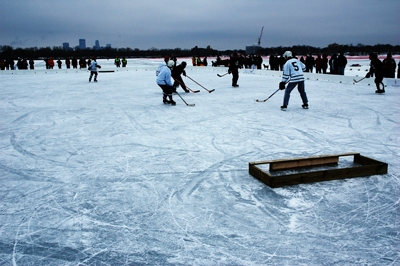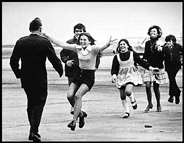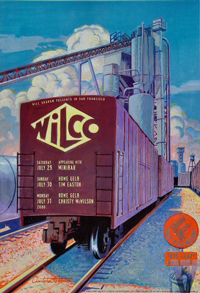 |
|---|
City Life
We love the city. There’s just so much to do. Even a minor metropolis like Minneapolis is often bursting with possibilities.
Let me give you some examples. On an ordinary Saturday morning in deep winter, we head down the parkway to the Lakes to watch the first annual International Pond Hockey Tournament.
Pond Hockey
I had never heard the expression “pond hockey” before. It refers to a game played with fewer skaters—four on a side—and no goalie. The goals are made of wood, they’re only about 2 inches high, with an opening on either side about twice the width of the puck. To score you must get the puck into one of those gaps in the face of the goal. There is no raising, no off-sides, no penalty for icing the puck, no face-offs, no checking. It’s the kind of hockey you used to play out on the pond behind the house when you were a kid, if you played hockey at all. Graceful and clumsy by turns, fast moving, and full of well-timed passes and embarrassing mistakes.
There are twenty-four rinks set up out here on the ice at the north end of the lake. More than a hundred teams have entered the tournament. Ninety more were turned away. They have names like the Mad Russians, the Happy Blades, the Dot.coms.
The “boards” that define the rink are only a few inches high, and there is no one standing in front of you. The crowds are spread out thinly across the ice, in fact, most are watching a particular boyfriend or spouse. You can wander from rink to rink to the sound of blades scraping ice and admire the hustle and the bright jerseys—red or turquoise or black. The action is never more than a few feet away.
But more stirring to an idle spectator like me than the good-natured competition taking place is the scene itself, with the early morning sun beaming in across the lake from the east, the blue ice, the brightly-colored winter coats, the sense of relaxed community participation.
It’s hard to tell what the score is in any given rink. The officials are wearing bright orange stocking caps. They could tell you who is beating whom if you asked.
I find that the teams that draw the largest crowds—I suppose because they’re considered the best—are bigger, they hustle more, and they dig out every puck. They play less gracefully, however, than those with only a smattering of fans. Or maybe it’s just that the sightlines are better, the sky is more fully in view, on those rinks where the spectators are fewer and the competition is less contentious. There’s something a little more fun about it.
Cafe Barbette
Following our visit to the ice, we head east up Lake Street to Cafe Barbette. That stretch of the street is one way, and there’s something about its width and angle of incline that makes it unusually satisfying to travel up. The shops are funky to the point of mediocrity—retro plastic toys, high-tech skateboard stuff, military collectables, bagel shops, tarot reading on the front porch, massages by sister Angelica—that kind of thing. My dentist used to have his office a few blocks up on the north side.
Whether Barbette is still trendy I have no idea, but it has endured, and the french fries are very good. (I have a suspicion they cook them in goose fat, though don’t ask me why. ) The decor is pleasing, the windows face south to catch the morning sun. The paintings on the walls are often interesting, the tiles on the pillars sparkle, and in short, the place exudes a degree of neighborly good taste.
The waffles are also tasty.
 |
|---|
The Pulitzer Photos
From here we cross the river to St. Paul to see the exhibit of Pulitzer Prize-winning photos before it leaves town. The show is packed, and you find yourself waiting in line as the crowd shuffles from photo to photo. I take the opportunity to step away from the line, darting into any open space that presents itself, moving from one side of the room to the other, while trying not to transgress the divisions that have been set up between decades.
What can be said about such photos?
1) Big photos are more dramatic than little ones.
I’m referring here simply to the size of the reproductions. Most of the photos on display are at least four feet tall. They seem more true-to-life because they’re almost as large as life.
2) Words tell us more than pictures.
Although pictures convey an impression with an immediacy that even a lengthy and detailed piece of text cannot, most of the visitors to the show spent most of their time reading the text that accompanies each shot, rather than looking at the picture itself. I would estimate the ratio to be 80% reading to 20% looking.
3) Disaster sells.
I’m going to give myself an Alzheimer test and see how many of the photos I can recall while sitting here are my desk, arranged by category.
• POLITICAL EXECUTIONS
— The priest absolving the victim in Cuba after Castro’s revolution, prior to execution
— A mass execution out in the deserts of Afganistan
— The famous pistol-to-the-head shot in Vietnam
— Dragging recently-executed bodies through the rain in El Salvador
— Young student wholloping a hanged student with a folding chair, Cambodia
• THE BRUTALITY OF WAR
— African setting fire to someone in a corn field
— Napalm family racing toward the camera
— Vietnamese family crossing a swollen river
— Hordes of African villagers in exile
— American GIs protect a man from a street crowd in Haiti
• MURDER AND MAYHEM
— Ruby shooting Oswald
— Political figure with shotgun fastened to his head by madman (San Francisco?)
— Crazy man running through front yard (Looks like Dennis Wilson of the Beach Boys.)
— young boy in back alley holding gun to another young boy
• CATASTROPHES
— World Trade Center in flames
— Andria Doria sinking
— waves pounding against lighthouse
— child and mother in freefall after fire escape collapse
— semi tractor hanging off edge of bridge
— young girl hit by car with flattened wagon in foreground
— firefighter holding injured baby
— exhausted firefighters taking a break
— starving abandoned baby with vulture looking on
— starving mother and child
• HUMAN INTEREST
— hole in Adlai Stevenson’s shoe
— Clinton talking to little girl
— Clinton with frosty Hilary behind him
— Iowa farmers losing their farm
— a portrait of some black share-croppers
SPORTS
— Nigerian women cheering their bronze medal
— American swimmer reaching up to fans in bleachers
4) Photojournalism is being at the right place at the right time.
We don’t admire most of the photos in the collection for their aesthetic qualities—though the images must be good in order to win. What fascinates us is to be seeing things (most of them bad things) we never thought we’d be in a position to see. The interest provided by the text lies in descriptions of how a particular photo got taken, what the photographer felt like to be photographing a murder (for example) instead of preventing it, what happened later to the photographer or the subjects in the photo.
I came away from the show confirmed in my opinion that the daily news bears only a distant relation to reality. It would be natural to imagine that in walking through five or six decades of prize-winning photos we have made some sort of deeper contact with history but such is not the case. If we don’t already know where Rwanda or Cambodia is, and what went on there; if we don’t already know who Adlai Stevenson, Monica Lewinsky, or Lee Harvey Oswald is, the photos tell us little. In the end all of the photos fall in the category of human, rather than historical interest. Bad things happen, sometimes people are not nice to one another. A woman hugging her son or husband’s gravestone in a military cemetery—you look at it, and it gets to you.
News remains a vital part of our world, of course, because by the time events take on the shape of history, with background, foreground, middle ground, sustained narrative, and informed analysis throughout, it’s too late to do anything about them.
Rock Art
 |
|---|
On another recent winter evening we went with our friends Dana and Mary to an opening at the Minneapolis College of Art and Design. The exhibit was called “Graphic Noise,” and it was devoted to rock-and-roll posters. The posters had been artfully arranged across five or six white walls in the lobby of the school, and they were colorful, varied, you can image. I had heard of very few of the bands being promoting on the posters, which is not surprising, but the posters themselves had that simplified silk-screen look and the overblown hard-to-read type-faces that are often very pleasant to look at. What I fould especially interesting, however, was the free pizza from Pizza Luce.
The music being played was fairly loud, and I believe a locally famous DJ was somewhere in the vicinity, but I was really surprised when someone arrived with a second stack of those white pizza-boxes. I kept looking around for the tip jar, but never spotted one. I also found it interesting that the young people who had gathered there seemed inordinately wan and pasty-faced, as if they’d been spending too much time indoors in front of a TV. Strange as it may seem, the older folks with grizzled beards looked more beady-eyed and quicker on their feet. There were far fewer of the old folks, however, and it occurred to me that these were simply the ones sharp enough to have survived.
Two bands were scheduled to appear later in the evening: STNNNG and The Deaths. Then, according to the ad, the party was set to move on to the Caterpillar Lounge at a Thai fusion restaurant down the street called Azia.
Before a single guitar had been removed from its case, however, we had long-since wandered outside and down the street. As we stolled west to Nicollet Avenue, Dana gave me a mini-tour of the houses and apartments of local residents who had garnered some sort of fame in the art or theater worlds, and before long we had reached our second destination for the evening—a Malaysian Restaurant called Peninsula.
I found the food there very interesting, and I also liked the pine walls, even though they gave you the feeling you were in a log cabin somewhere a long way from Singapore.